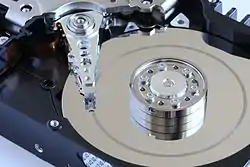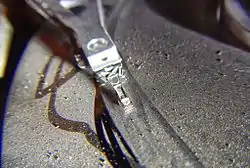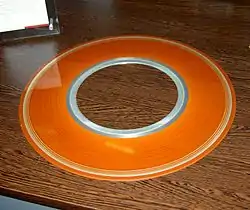Head crash
A head crash is a hard-disk failure that occurs when a read–write head of a hard disk drive makes contact with its rotating platter, slashing its surface and permanently damaging its magnetic media. It is most caused by a sudden severe motion of the disk, for example the jolt caused by dropping a laptop to the ground while it is operating or physically shocking a computer.


Head details
A head normally rides on a thin film of moving air entrapped at the surface of its platter (some drives manufactured by Conner Peripherals in the mid-1990s used a thin liquid layer instead[1]). The distance between the head and platter is called the flying height. The topmost layer of the platter is made of a Teflon-like material that acts like a lubricant. Underneath is a layer of sputtered carbon. These two layers protect the magnetic layer (data storage area) from most accidental touches of the read-write head.[2]
The disk read-and-write head is made using thin film techniques that include materials hard enough to scratch through the protective layers. A head crash can be initiated by a force that puts enough pressure on the platters from the heads to scratch through to the magnetic storage layer. A tiny particle of dirt or other detritus, excessive shock or vibration (such as accidentally dropping a running drive), can cause a head to bounce against its disk, destroying the thin magnetic coating on the area the heads come in contact with, and often damaging the heads in the process. After this initial crash, countless numbers of fine particles from the damaged area can land onto other areas and can cause more head crashes when the heads move over those particles, quickly causing significant damage and data loss, and rendering the drive useless. Some modern hard disks incorporate free fall sensors to offer protection against head crashes caused by accidentally dropping the drive.
Differences at RPMs
Since most modern drives spin at rates between 5,400 and 15,000 RPM, the damage caused to the magnetic coating can be extensive. At 7,200 RPM, the edge of the platter is traveling at over 120 kilometres per hour (75 mph), and as the crashed head drags over the platter surface, the read-write head generally overheats, making the drive or at least parts of it unusable until the heads cool.

Older heads
Older drives typically rotated far more slowly and had larger heads flying higher above the surface of the medium. However, since in many cases, the medium was housed in a removable cartridge or pack and since air filtration was comparatively crude, crashes were fairly frequent and invariably expensive.
Laptops
Head crashes have been a frequent problem on laptop computers since the introduction of Hard Drive Disks, which in cases such as sudden drops, or movements would cause the head to "Crash" which would case the head to strike and get stuck on the platter causing irrecoverable data loss known as scoring. This has led to the development of technologies that detect sudden motion and in the case of sudden power failure, to "park" the head, sometimes known as active hard-drive protection or "sudden motion sensing". Active Hard Disk Protection software and sensors began appearing in laptops around the year 2000, becoming commonality around 2006 with the introduction of Windows 7 [3]These drives are designed to "self-park" during sudden power loss, this has led in turn to less instances of head-crash and with the introduction of SATA SSD and modern M.2 Drives this issue has been nearly eliminated in modern laptops.
References
- Bonnier Corporation (April 1993). Popular Science. Bonnier Corporation. pp. 48–.
- Wiederrecht, Gary Phillip (2010). Handbook of nanoscale optics and electronics, p. 257. Academic Press. ISBN 978-0-12-375178-2
- "HP Notebook PCs - Use ProtectSmart to Prevent Hard Drive Damage". 28 December 2020.